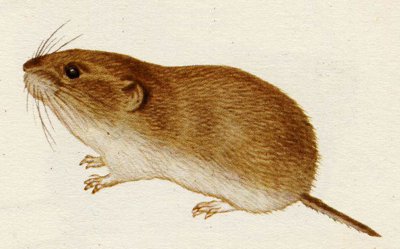Pests
Lasiopodomys brandti (Radde, 1852) - Brandt's vole (Steppe vole).
Systematic position.
The class Mammalia, order Rodentia, family Cricetidae, subfamily Microtinae, genus Lasiopodomys. The species comprise 2 subspecies.Biological group.
Rodent pests.Morphology and biology.
Body length up to 130-150 mm, tail length up to 26-35 mm, 15-25% of body length on the average, but no more than 29%. Ears are small, hardly projected out of fur. Coloration is light, with predominance of sandy-ochre tones of various intensities. The tail is monochrome or gently dichromatic. The hind part of the foot is covered with dense hairs. Diploid set of chromosome, 34. Lives in dry cereal steppes, sometimes on meadows at steppe lakes and along river valleys. Establishes large colonies. Typical hole-digger; each family establishes composite holes, with winter hole in the center and fodder and protective holes surrounding the center hole. The holes are connected to each other by a web of paths and long underground passages.Distribution.
Mongolia and North-east China. In the former USSR; southern Transbaikalia.Ecology.
Unlike other voles the species is active during the day. Feeds on both the under-ground and above-ground parts of plants. In autumn it accumulates large stores in underground store-rooms. In winter the animal activity is reduced and they feed by victuals. High fertility is characteristic of the species; 4-5 broods during the year under favorable conditions, with 6-8, sometimes 12-15 and even 17 young voles in each brood. Population dynamics are subject to strong oscillations; from depression, when the colonies completely disappear in large territories, remaining in niduses and microniduses at reservation stations, to mass outbreak, when millions of hectares of pastures (in Mongolia) are invaded.Economic significance.
Some years this species damages pastures and completely destroys fodder vegetation. In areas of the vole settlements the micro-relief and soil covering are essentially degraded. As a result of their intensive digging activity, poor and saline soils are moved to the surface. Such sites remain bald for a long time and overgrow step-by-step by weeds. In places animals damage truck crops. This species is the constant carrier of pathogens of many epizootic infectious diseases. Baits are the only way to control this species.Reference citations:
Gromov I.M., Polyakov I.Ya. 1977. Voles (Microtinae). In: Strelkov A.A., ed. Series Fauna of the USSR. Mammals. V. 3. Issue 8. Leningrad: Nauka. 504 pp. (In Russian)Khrustselevskii V.P. 1952. Materials on ecology of Brandt's vole. Report 3. Trans. Antiplague Institute of Siberia and the Far East. V. 10. Irkutsk: Antiplague Institute of Siberia and the Far East. 76-85 pp. (In Russian)
Khrustselevskii V.P. 1954. Regularities in number changes of Brandt's vole in southeast Transbaikalia. Trans. Antiplague Institute of Siberia and the Far East. V. 13. Irkusk: Antiplague Institute of Siberia and the Far East. 81-105 pp. (In Russian)
Khrustselevskii V.P., Gorodetskaya T.A., Kopylova O.A. 1952. Materials on ecology of Brandt's vole. Report 2. Trans. Antiplague Institute of Siberia and the Far East. V. 10. Irkusk: Antiplague Institute of Siberia and the Far East. 54-75 pp. (In Russian)
Sokolov I.I., ed. 1963. Mammalian fauna of the USSR. Part I. Leningrad: Izd. AN SSSR. 638 pp. (In Russian)


